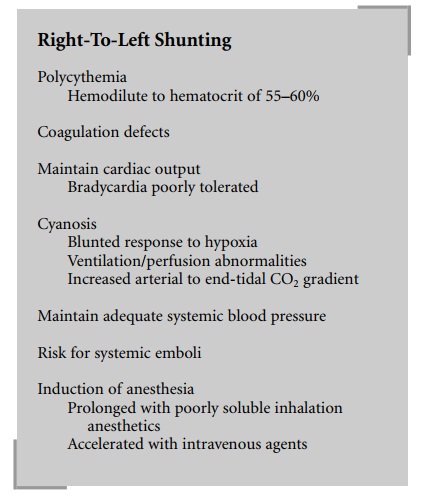Chapter: Clinical Cases in Anesthesia : Congenital Heart Disease
What are the anesthetic implications of right-to-left shunting lesions?
What are
the anesthetic implications of right-to-left shunting lesions?
In older cyanotic patients with severe
polycythemia, hemodilution to a hematocrit of 55–60% should be per-formed prior
to elective surgery. This will improve cardiac output, peripheral perfusion,
and oxygen transport. It may also improve the coagulation defects commonly
found in polycythemic patients. However, hemodilution to normal levels may be
detrimental because oxygen transport will be seriously limited. Maintenance of
cardiac output is essential since the oxygen content of the blood is low.
Therefore, bradycardia is poorly tolerated.
Patients with cyanosis have a blunted response
to hypoxia, which may persist even after correction of the underlying lesion.
In patients with reduced pulmonary blood flow, marked ventilation/perfusion
inequalities exist. Positive pressure ventilation may worsen this problem,
leading to an increase in dead space ventilation and raised arterial carbon
dioxide tension (PaCO2). However, to maintain normal PaCO2
with severely reduced pulmonary blood flow, a moderate degree of
hyperventilation is required. Capnography underestimates PaCO2 in
these patients, since only part of the cardiac output will reach the pulmonary
circulation for gas exchange. The greater the right-to-left shunt, the higher
the arterial to end-tidal CO2 (ETCO2) gradient. Thus, a
markedly increased PaCO2 may be present despite a normal ETCO2.
In patients with systemic-to-pulmonary shunts,
ade-quate systemic blood pressure is necessary to maintain pul-monary
perfusion, besides reducing right-to-left shunting at the cardiac level.
The presence of a right-to-left shunt prolongs
induction with poorly soluble inhalation anesthetics. This may be offset by the
presence of a surgically created systemic-to-pulmonary shunt. Induction time
with highly soluble agents may be nearly normal because these patients usually
hyperventilate to maintain a normal PaCO2. The onset of action of
intravenous agents is accelerated since a signifi-cant proportion of the drug
bypasses the lungs.

All patients with right-to-left shunts are at
an increased risk of systemic embolization of air or blood clots from IV lines.
Related Topics